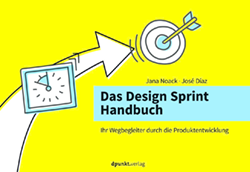terminology related to innovative entrepreneurship
When working with innovation methods from the field of design thinking and agile methods, there are a few terms that are important for you to know:
Design sprints are one of the innovation methods that help to develop new ideas for new products and services quickly, in a resource-saving manner and with little entrepreneurial risk. For established companies, they are the key to being competitive on the market in the long term. Young companies and start-ups use this approach to position themselves in the market and reach their target groups. Design Sprints are also suitable within companies or any other kind of community where people live or work together to find new ways to solve various problems, challenges, structures and existing issues.
trendig has specialized in the facilitation of Design Sprints. trendig's team of experienced Design Sprint masters (in English "facilitators") lead the participants in the training sessions through a real project and let them experience an entire Sprint from the participant's point of view and work out an innovative solution. Along the way, they explain the theoretical basics of design thinking and agile working methods and explain how to get from a customer-tested prototype to implementation with the (software) development team by means of a well thought-out product vision.

In 2019, trendig has published a book about the experiences with Design Sprints in companies: The Design Sprint Handbook ISBN 978-3-86490-656-5. In this handbook, trendig's Design Sprint Masters explain step by step how to conduct a four-day Design Sprint as a Sprint Master and thus advance their own product development. The book guides the reader through the entire sprint, providing flowcharts, guidelines, and checklists that cover everything from preparing to executing to wrap-up a design sprint. In addition, the authors provide insights into their working methods and tips and hacks that they have gathered during their many years of work in design sprints.
Design thinking is more of a mindset than an agile innovation method: It means a customer-oriented perspective in innovative creation processes of all kinds. And not only in software development. Form follows function or fail fast, fail early are keywords from this way of working. A design thinking process consists of several successive phases in which, starting from a challenge or a customer need, a diverse team tries to first understand the problem and observe the customer needs, find ideas, build a mock-up-like prototype (in software development usually a click dummy) and finally test it with real users. The length and scope of these phases are not predetermined! It is explicitly designed as an iterative approach and any number of new starts, even in early phases, to review or revise ideas.
Design sprints are a version of design thinking in which several design thinking techniques are performed with a team in five successive linear phases. At the end of this four or five days process, a prototype for a specific challenge is created and gets tested with five customers. In addition to phase orientation and speed (sprint), the framework is based on visual and haptic preparation (design) and the validation of ideas. Strict timeboxing (i.e., assigning fixed timelines in which certain work steps must be completed), meticulous preparation and an experienced Design Sprint Master are important for this approach.
trendig has published a book about its experiences with Design Sprints 2o19 with dpunkt-Verlag: Das Design Sprint Handbuch ISBN 978-3-86490-656-5.
Think big, but start small - that's the idea behind Lean Startup. Doing as much as necessary, but using as few human, financial and time resources as possible. If a team has an idea, it must turn it into a sufficiently functioning prototype as early as possible and test it with customers. Even though the method has "startup" in its name, it is suitable for almost all companies. After all, planning for the future, reacting in an agile manner to changes, being fast - these are the requirements of all companies today that are facing up to digitization and globalization and their disruptive transformation processes.
The Minimum Viable Product (MVP) is a sufficiently functional version of a product, interface or service. It enables a business idea to be brought to market quickly and with minimal effort, and to test whether it meets the needs of users and later customers. Based on the feedback on this first version, further development steps can be adapted and resources can be aligned more specifically with customer requirements. This is often referred to as the build-measure-learn cycle (build: quickly develop a product and test it with customers. measure: measure what works and what needs improvement. learn: Incorporate what is learned from feedback into the next improved version).
A product vision statement describes the ideal product from the customer's point of view. Can the product optimally address their needs and solve existing problems for the customers? If so, this means a so-called problem-solution fit. A product vision is simply formulated and easy to understand. Clear actions are derived from it and the (development) team can assess whether it has sufficient competencies to create this product. Particularly in agile teams, the product vision is important in order to achieve an alignment focused on the end product, despite the autonomy of the individual employees.
Wenn Du mehr über Scrum, Kanban, Lean Startup und Co wissen möchtest, dann schau auf unserer Website zu Agile Practices & Agile Testing vorbei. https://trendig.com/en/training/agile-practices-agile-testing/


